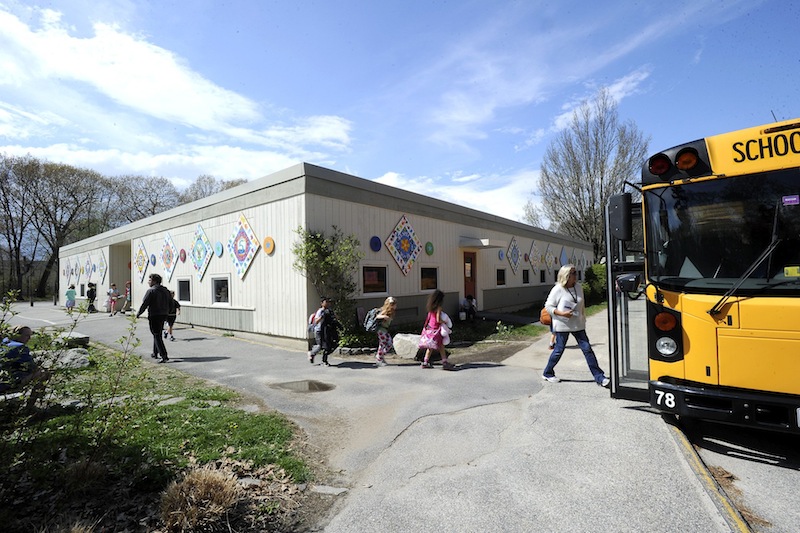A Portland elementary school that was damaged by fire two years ago and two aging high schools in midcoast Maine are guaranteed to receive state aid to build new facilities or renovate their existing buildings.
The State Board of Education on Wednesday voted to accept Commissioner James E. Rier Jr.’s recommendation to add six schools, including Portland’s Fred P. Hall School, to the state’s Major Capital School Construction Approved Projects List. Portland is estimating that it will cost more than $20 million to replace the Hall School, though state education officials say it is too early to put a pricetag on any of the projects.
Rier estimates that it could take two or three years before sites are selected and construction on the newly approved projects can even begin. Not one of the six school projects, including the Sanford High School & Regional Technical Center, that were approved for funding in 2012 have started construction.
“This means these (new) projects are entering the planning stages, which can be a fairly lengthy process,” Rier said Wednesday night during a telephone interview. “We are talking about building a school that will last 40, maybe 50 years. Each school project will have a different path to follow.”
The most current state approved projects list now includes funding for 12 school construction projects ranked in order of priority. Rier said the schools that were approved for funding two years ago are each in various stages of planning and development.
Mt. Ararat High School in Topsham was ranked 7th on the new funding list, followed by Morse High School in Bath at the 11th spot. Hall School was ranked 12th. Also making the 2014 list were the Martel School in Lewiston at number eight, Monmouth Middle School was ranked 9th, and Teague Park School in Caribou 10th.
Rier said it has not been determined whether Morse or Mt. Ararat will be renovated or replaced.
Morse High School serves six midcoast communities and is a warren of old rooms, cramped hallways and meeting spaces. It was rebuilt in 1929 following a fire, with an addition built in 1969. In 1996, the school district added a vocational center to one end of the high school.
Mt. Ararat High School serves four midcoast towns and opened in the early 1970s. In its early years it served students in grades 7-12 but part of the student population had to be moved due to overcrowding. The district opened a new middle school in Topsham in 2001. School Administrative District 75 has indicated that it would like to build a new high school on land adjacent to the existing high school.
“We really appreciate the state recognizing the importance of this critical project,” Portland Schools Superintendent Emmanuel Caulk said in a statement released Wednesday. “Replacing Hall has been our district’s top priority for building improvements.”
Hall School, which was built in 1956, is a one-story building on Orono Road in Portland’s Deering neighborhood. It is a short walk from Sagamore Village.
Hall School is in rough shape. It was damaged by an electrical fire in September 2012 that forced the school department to relocate staff and students for two weeks. Ponds of water form on its roof after rainstorms and the school is plagued with rotting wood siding and sills and some building materials that contain asbestos.
In 2012, Portland’s school district hired Oak Point Associates to develop preliminary design plans, tentative construction schedules and estimated project costs for Hall School, Longfellow School, Lyseth School, Presumpscot School and Reiche School. The total price tag for renovating and expanding all five schools exceeded $70 million but city officials were told that Longfellow – with an estimated pricetag of $15 million – was ranked 18th on the school construction funding list and could possibly be approved for state aid in the near future.
Portland Mayor Michael Brennan said the city is interested in accelerating the replacement of Hall School. A state provision – known as local option financing – would allow the city to bond the project in advance of the state bonding cycle provided that the city agrees to pay the interest costs associated with the loan. Those interest costs would go away once the city started receiving state assistance. Such an arrangement would have to be approved by voters.
“I think it (not waiting for the state funds) is a reasonable and viable option given the fact that Hall School is not in a very good situation,” Brennan said. “Its need to be replaced is very well documented.”
Last July, the Board of Education asked the City Council to hold a November 2013 referendum on voter approval for a $39.9 million referendum to improve Lyseth, Reiche and Presumpscot schools. The bond would not have included Longfellow. Councilors told school officials that they wanted to be certain that the state would fund improvements to Hall and Longfellow before sending the question to voters.
“We feel there is a 50-50 chance for Longfellow to get state funding,” Brennan said. “My certainty that it will get funding is not as great as it was.”
Staff Writer Dennis Hoey can be contacted at 791-6365 or at:
dhoey@pressherald.com
Send questions/comments to the editors.




Success. Please wait for the page to reload. If the page does not reload within 5 seconds, please refresh the page.
Enter your email and password to access comments.
Hi, to comment on stories you must . This profile is in addition to your subscription and website login.
Already have a commenting profile? .
Invalid username/password.
Please check your email to confirm and complete your registration.
Only subscribers are eligible to post comments. Please subscribe or login first for digital access. Here’s why.
Use the form below to reset your password. When you've submitted your account email, we will send an email with a reset code.